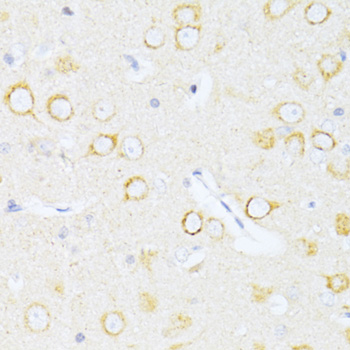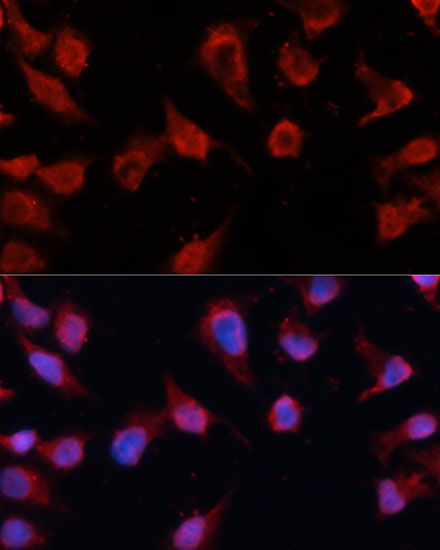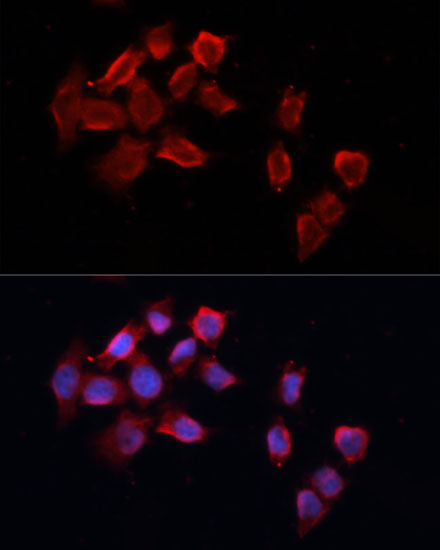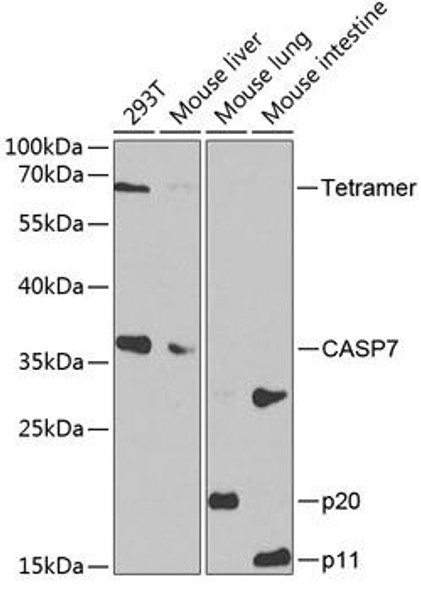Cell Death Antibodies 1
Anti-Caspase-8 Antibody (CAB11324)
- SKU:
- CAB11324
- Product Type:
- Antibody
- Reactivity:
- Human
- Reactivity:
- Mouse
- Reactivity:
- Rat
- Host Species:
- Rabbit
- Isotype:
- IgG
- Antibody Type:
- Polyclonal Antibody
- Research Area:
- Cell Death
Description
| Antibody Name: | Anti-Caspase-8 Antibody |
| Antibody SKU: | CAB11324 |
| Antibody Size: | 20uL, 50uL, 100uL |
| Application: | WB IHC IF |
| Reactivity: | Human, Mouse, Rat |
| Host Species: | Rabbit |
| Immunogen: | Recombinant protein of mouse Caspase-8 |
| Application: | WB IHC IF |
| Recommended Dilution: | WB 1:500 - 1:2000 IHC 1:50 - 1:200 IF 1:50 - 1:200 |
| Reactivity: | Human, Mouse, Rat |
| Positive Samples: | Mouse thymus |
| Immunogen: | Recombinant protein of mouse Caspase-8 |
| Purification Method: | Affinity purification |
| Storage Buffer: | Store at -20'C. Avoid freeze / thaw cycles. Buffer: PBS with 0.02% sodium azide, 50% glycerol, pH7.3. |
| Isotype: | IgG |
| Sequence: | Email for sequence |
| Gene ID: | 12370 |
| Uniprot: | Q14790 |
| Cellular Location: | Cytoplasm |
| Calculated MW: | 55kDa |
| Observed MW: | 58kDa |
| Synonyms: | CASP8, ALPS2B, CAP4, Casp-8, FLICE, MACH, MCH5, caspase-8, Caspase 8, Casp8 |
| Background: | This gene encodes a member of the cysteine-aspartic acid protease (caspase) family. Sequential activation of caspases plays a central role in the execution-phase of cell apoptosis. Caspases exist as inactive proenzymes composed of a prodomain, a large protease subunit, and a small protease subunit. Activation of caspases requires proteolytic processing at conserved internal aspartic residues to generate a heterodimeric enzyme consisting of the large and small subunits. This protein is involved in the programmed cell death induced by Fas and various apoptotic stimuli. The N-terminal FADD-like death effector domain of this protein suggests that it may interact with Fas-interacting protein FADD. This protein was detected in the insoluble fraction of the affected brain region from Huntington disease patients but not in those from normal controls, which implicated the role in neurodegenerative diseases. Many alternatively spliced transcript variants encoding different isoforms have been described, although not all variants have had their full-length sequences determined. |
| UniProt Protein Function: | CASP8: Most upstream protease of the activation cascade of caspases responsible for the TNFRSF6/FAS mediated and TNFRSF1A induced cell death. Binding to the adapter molecule FADD recruits it to either receptor. The resulting aggregate called death- inducing signaling complex (DISC) performs CASP8 proteolytic activation. The active dimeric enzyme is then liberated from the DISC and free to activate downstream apoptotic proteases. Proteolytic fragments of the N-terminal propeptide (termed CAP3, CAP5 and CAP6) are likely retained in the DISC. Cleaves and activates CASP3, CASP4, CASP6, CASP7, CASP9 and CASP10. May participate in the GZMB apoptotic pathways. Cleaves ADPRT. Hydrolyzes the small-molecule substrate, Ac-Asp-Glu-Val-Asp-|-AMC. Likely target for the cowpox virus CRMA death inhibitory protein. Isoform 5, isoform 6, isoform 7 and isoform 8 lack the catalytic site and may interfere with the pro-apoptotic activity of the complex. Heterotetramer that consists of two anti-parallel arranged heterodimers, each one formed by a 18 kDa (p18) and a 10 kDa (p10) subunit. Interacts with FADD, CFLAR and PEA15. Isoform 9 interacts at the endoplasmic reticulum with a complex containing BCAP31, BAP29, BCL2 and/or BCL2L1. Interacts with TNFAIP8L2. Interacts with human cytomegalovirus/HHV-5 protein vICA/UL36; this interaction inhibits CASP8 activation. Isoform 1, isoform 5 and isoform 7 are expressed in a wide variety of tissues. Highest expression in peripheral blood leukocytes, spleen, thymus and liver. Barely detectable in brain, testis and skeletal muscle. Belongs to the peptidase C14A family. 9 isoforms of the human protein are produced by alternative splicing. |
| UniProt Protein Details: | Protein type:Protease; EC 3.4.22.61; Apoptosis Chromosomal Location of Human Ortholog: 2q33-q34 Cellular Component: nucleoplasm; mitochondrial outer membrane; neuron projection; cytoskeleton; mitochondrion; Noc1p-Noc2p complex; cytoplasm; microtubule organizing center; CD95 death-inducing signaling complex; cytosol; lipid raft Molecular Function:peptidase activity; protein binding; protein heterodimerization activity; cysteine-type endopeptidase activity; ubiquitin protein ligase binding; death receptor binding; protein complex binding; tumor necrosis factor receptor binding; cysteine-type peptidase activity Biological Process: macrophage differentiation; T cell activation; viral reproduction; apoptosis; protein heterooligomerization; positive regulation of proteolysis; heart development; natural killer cell activation; response to lipopolysaccharide; toll-like receptor 3 signaling pathway; proteolysis; response to estradiol stimulus; response to antibiotic; proteolysis involved in cellular protein catabolic process; angiogenesis; positive regulation of macrophage differentiation; toll-like receptor 4 signaling pathway; cell structure disassembly during apoptosis; caspase activation; positive regulation of I-kappaB kinase/NF-kappaB cascade; B cell activation; MyD88-independent toll-like receptor signaling pathway; negative regulation of I-kappaB kinase/NF-kappaB cascade; response to ethanol; induction of apoptosis via death domain receptors; toll-like receptor signaling pathway; response to cobalt ion; innate immune response; response to cold; neural tube formation Disease: Caspase 8 Deficiency; Breast Cancer; Lung Cancer; Hepatocellular Carcinoma |
| NCBI Summary: | This gene encodes a member of the cysteine-aspartic acid protease (caspase) family. Sequential activation of caspases plays a central role in the execution-phase of cell apoptosis. Caspases exist as inactive proenzymes composed of a prodomain, a large protease subunit, and a small protease subunit. Activation of caspases requires proteolytic processing at conserved internal aspartic residues to generate a heterodimeric enzyme consisting of the large and small subunits. This protein is involved in the programmed cell death induced by Fas and various apoptotic stimuli. The N-terminal FADD-like death effector domain of this protein suggests that it may interact with Fas-interacting protein FADD. This protein was detected in the insoluble fraction of the affected brain region from Huntington disease patients but not in those from normal controls, which implicated the role in neurodegenerative diseases. Many alternatively spliced transcript variants encoding different isoforms have been described, although not all variants have had their full-length sequences determined. [provided by RefSeq, Jul 2008] |
| UniProt Code: | Q14790 |
| NCBI GenInfo Identifier: | 2493531 |
| NCBI Gene ID: | 841 |
| NCBI Accession: | Q14790.1 |
| UniProt Secondary Accession: | Q14790,O14676, Q14791, Q14792, Q14793, Q14794, Q14795 Q14796, Q15780, Q15806, Q53TT5, Q8TDI1, |
| UniProt Related Accession: | Q14790 |
| Molecular Weight: | |
| NCBI Full Name: | Caspase-8 |
| NCBI Synonym Full Names: | caspase 8, apoptosis-related cysteine peptidase |
| NCBI Official Symbol: | CASP8 |
| NCBI Official Synonym Symbols: | CAP4; MACH; MCH5; FLICE; ALPS2B; Casp-8 |
| NCBI Protein Information: | caspase-8; FADD-like ICE; MACH-alpha-1/2/3 protein; apoptotic protease Mch-5; MACH-beta-1/2/3/4 protein; apoptotic cysteine protease; ICE-like apoptotic protease 5; MORT1-associated ced-3 homolog; FADD-homologous ICE/CED-3-like protease; caspase 8, apoptosis-related cysteine protease |
| UniProt Protein Name: | Caspase-8 |
| UniProt Synonym Protein Names: | Apoptotic cysteine protease; Apoptotic protease Mch-5; CAP4; FADD-homologous ICE/ced-3-like protease; FADD-like ICE; FLICE; ICE-like apoptotic protease 5; MORT1-associated ced-3 homolog |
| Protein Family: | Caspase |
| UniProt Gene Name: | CASP8 |
| UniProt Entry Name: | CASP8_HUMAN |








![Anti-Caspase-8 Antibody [KO Validated] (CAB19549) Anti-Caspase-8 Antibody [KO Validated] (CAB19549)](https://cdn11.bigcommerce.com/s-rd6ounxcu2/images/stencil/590x590/products/55923/61105/anti-caspase-8-antibody-ko-validated-cab19549__65416__44661.1706533711.jpg?c=1)

